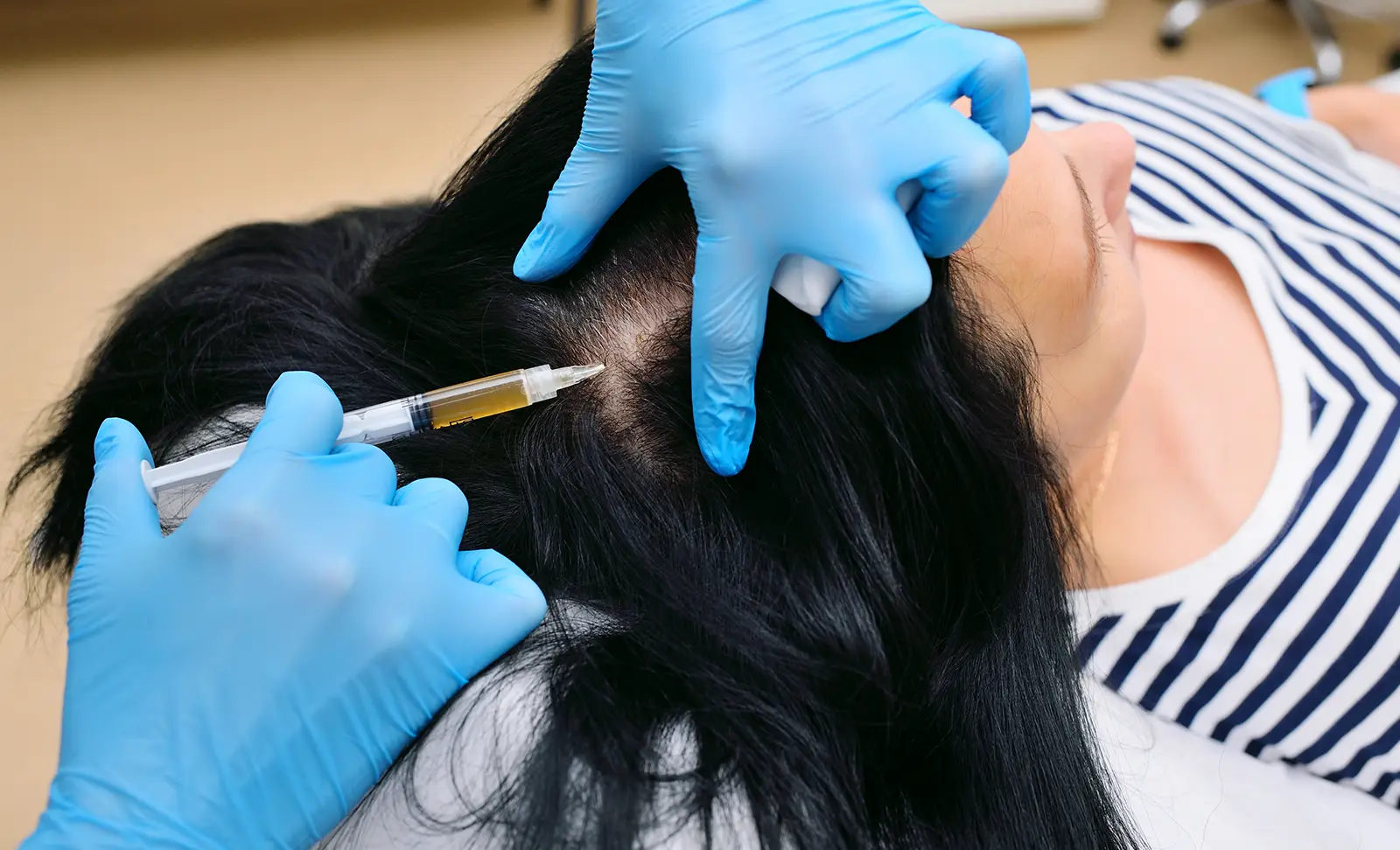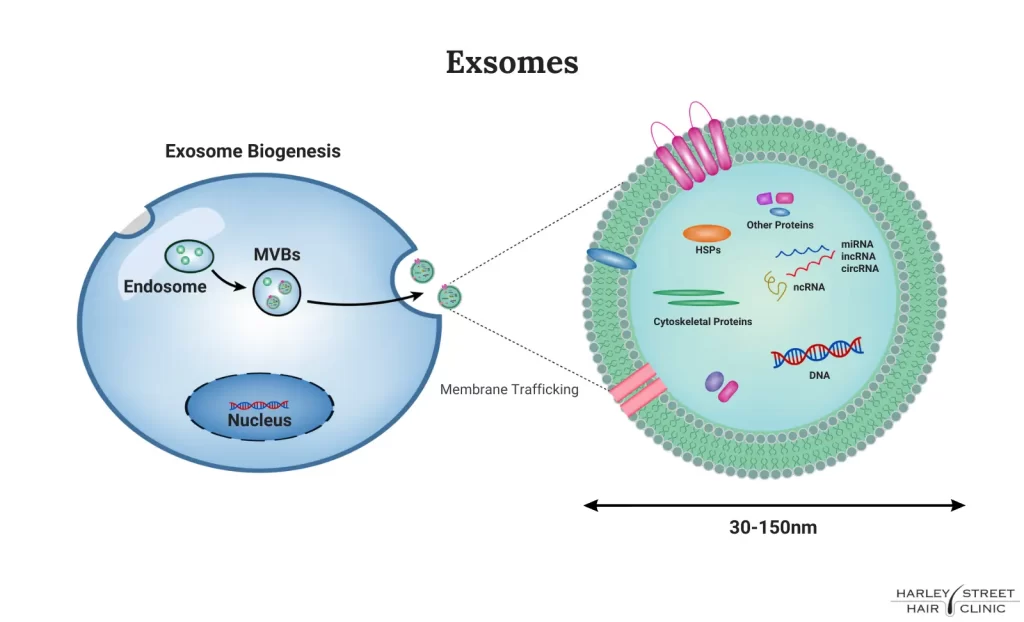If you experience hair loss, it’s natural to seek a hair loss treatment that restores your locks to how they once were. You may have heard of the more well-known methods, such as hair transplants and minoxidil (Rogaine), but what about exosomes? These minuscule particles may be the key to entire hair restoration.
If you have experienced hair loss and are interested in learning about an exciting hair regeneration method, you’re in the right place – discover everything you need to know about exosomes for hair growth right here.
What Are Exosomes?
Exosomes are tiny particles released by stem cells within the human body and are around 30-150nm in diameter. [1] They get released into the bloodstream, carrying proteins, growth factors, and DNA. They are like messengers and are responsible for cell regeneration, which is why they work well in hair growth treatments.
How Do Exosomes for Hair Loss Work?
Here are a few ways that exosomes can boost hair follicle growth:
Stimulating Hair Follicles
One of the main reasons people experience hair loss is due to dormant hair follicles; when the hair follicles are not active, no hair can grow from them. It makes sense, then, to stimulate hair follicles, and that’s exactly what exosomes can do. The growth factors within exosomes can revitalise dormant hair follicles, leading to more hair growth and thicker hair density.
Prolonging the Growth Phase
Everyone’s hair goes through the hair growth cycle, which involves the catagen phase (transitional), telogen phase (resting), exogen phase (shedding), and anagen phase (active). [2] Hair loss often occurs when the hair follicles stay dormant in the telogen phase for too long. Exosomes can reverse that, making hairs in the telogen phase reach the anagen phase, which restores growth and leads to thicker hair.
Improving Hair Follicle Health
Healthy hair follicles will always produce healthier, thicker hair. Exosomes are key to reparation and are able to accelerate hair follicle reparation. As a result, it can boost hair growth.
Boosting Blood Flow
Blood flow to the scalp (and follicles) is essential for growth, as it ensures the area receives all the nutrients that are necessary. Exosomes hair loss therapy, especially exosomes that include VEGF vascular endothelial growth factor, works by boosting blood flow to the hair follicles, stimulating the area and encouraging newer, fuller growth.
The Process of Exosomes Hair Loss Therapy: What to Expect
You now understand how exosome hair treatments work, but what can you expect? Here’s the typical process.
- Consultation
Before any clinical treatment, you must attend a consultation. This is to ensure you are a good candidate for the treatment. You can also discuss expectations and the treatment plan that would best work for you and your specific hair loss/thinning symptoms.
- Drawing Blood
On the day of the exosome hair treatment, the first step will be a blood draw. It’s a simple, relatively speedy step that involves collecting some blood from your own body, which will then be used for the treatment.
- Isolating the Exosomes
The next step doesn’t involve you – the patient – at all. The doctor will send your bloodwork to a special lab where it will be prepared for the treatment. It involves isolating and extracting the exosomes.
- Injecting the Scalp
Next, the derived exosomes from your blood get injected straight into your scalp, specifically the areas affected by hair loss or thinning. Your scalp will likely be numbed for this section to ensure your absolute comfort.
- Recovery
You can usually go home the same day of the treatment and recover in your own space. There will be some recovery time; you will likely experience some tenderness at the injection sites. However, this should lessen quite quickly, and you can typically return to your usual hair care routine in a couple of days.
- Hair Growth
This is the bit people look forward to: the first sign of new hair growth. For some, new hair growth can happen in just a couple of months. However, for most patients, it takes around six months to see visible results from the exosome hair loss treatment. You will usually be called back to the clinic to check your progress. You can also use a hair track app to monitor the progress yourself.
The Benefits of Exosomes Hair Loss Treatment
So, what are the benefits of exosome treatment for hair loss?
It is Minimally Invasive
One of the main advantages of the exosome hair loss treatment is that it’s minimally invasive. The treatment itself only involves a blood draw and then some injections into the scalp – no surgery required.
There Have Been Promising Results
While research into the effectiveness of exosomes as a treatment for hair loss is still in the early stages, it’s safe to say the results have been promising so far. In one study in South Korea, 39 patients who went through 12 weeks of exosome treatment experienced noticeably improved hair thickness and density. [3]
It Uses Your Body’s Natural Healing Processes
Some people do not like the idea of using foreign substances and chemicals within their bodies. That’s not an issue with using exosomes – they are naturally occurring and already present inside you. The process of exosome hair treatment involves extracting them from your blood and then using them to stimulate growth. It is all about using your very own natural healing processes!
Long Lasting Results
Some hair treatments require daily use. For example, minoxidil and finasteride are hair loss treatments you must keep up with daily for the results to stick. That’s not necessarily the case with exosomes – the results are long-lasting, giving you natural growth for a long time.
Natural Results
Some hair restoration options, such as hair pieces and fibres, can look unnatural. That’s not the case with exosomes – as they stimulate already present hair follicles within the scalp, it means the hair that grows through is completely natural.
It Can Help with Scalp Disorders
Exosome injections can also be beneficial for treating certain scalp disorders, such as seborrhoeic dermatitis, as well as helping with hair loss in general. That is thanks to the growth factors within exosomes, which trigger the healing process.
It Can Restore Confidence
Promoting hair growth is crucial for many people who have experienced hair loss. Losing your hair can lead to self-consciousness, while the ability to restore hair growth and density means improved confidence. That can impact almost every area of your life.
The Downsides of Exosomes Hair Loss Treatment
What about the potential downsides? Here are some to consider.
It is Not 100% Effective
No one can say that exosomes for hair growth are 100% effective. The research is still in its early stages, and while there have been promising results, that does not mean every person who receives the treatment will enjoy thicker, denser hair.
Potential Side Effects
There is a chance patients will experience side effects after the treatment. Common, less serious ones include discomfort, redness, swelling, and tenderness. However, there is the risk of more serious side effects, such as an allergic reaction and an infection.
Discomfort During Treatment
Overall, as a treatment option for hair growth, exosome therapy is minimally invasive. However, many patients will still experience some discomfort during the procedure.
High Cost
The cost of exosome hair therapy varies depending on the clinic you choose, but it can be quite expensive in some situations. It is best to choose a high-quality clinic, which will usually mean a more expensive treatment.
Exosome Hair Therapy vs Hair Transplants
When looking into ways of enhancing hair growth, most people come across hair transplants, the hair restoration surgery that takes healthy hair follicles from one section of the scalp and transplants them into the thinning or balding area. If you are undecided between exosome hair therapy and a hair transplant, here are the key differences to consider:
Invasiveness
While hair transplants are a minimally invasive type of surgery, there is no denying that a blood draw and some injections are even less invasive. The recovery time for exosome therapy is shorter, too.
Price
Exosome hair therapy may cost money, but hair transplants are typically more expensive. Getting exosome therapy for hair loss may set you back £200-900, but a hair transplant will cost thousands, depending on the number of grafts you require.
Effectiveness
Hair transplants are undoubtedly more effective than exosomes for hair restoration. While exosomes may boost hair growth, leading to thicker, denser hair, a hair transplant is the better option for targeting androgenetic alopecia (male or female pattern baldness). It can fully restore a hairline and thinning crown, with the results lasting a lifetime.
Exosomes Hair Loss Treatment: In Summary
Exosomes provide a promising treatment for growing healthier, thicker hair. The growth factors and proteins within exosomes allow them to boost blood flow and stimulate the hair follicles. The treatment is pretty straightforward, too, with most patients experiencing minimal discomfort.
It must be said, though, that exosome hair therapy is still in its early stages. If you’re looking for a better-researched, more effective hair restoration option, contact our team today to learn about our hair transplant procedures, or head to our patients gallery to see the results we provide.
Sources:





